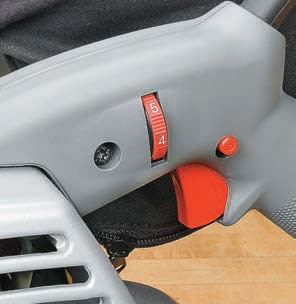
When you need to remove a lot of material in a short time, a belt sander is your go-to tool. Whether you’re in the market for your first belt sander or thinking about replacing one that you’ve had for awhile, there are a few things to think about before you do.
Several factors enter into choosing the right belt sander. To start with, I look at some primary features, such as size, overall design, and ruggedness of construction. Then I decide on some subjective features, such as variable speed options, dust collection and finally how the tool feels in my hands in use.

SIZE. The size of a belt sander is measured by the width and length of the belt. Belts range in size from small, detail-type sanders with belts that are only an inch or two wide to heavy-duty 4" x 24" machines. A common size for home shop use is a 3" x 21" sander. This size offers a sizeable sanding area, without the fatigue generated by running a large machine. I think you’ll find it can handle most tasks in the shop.
PLATEN. The main advantage of a belt sander is the speed as which it removes stock. And key to keeping a surface flat during this aggressive stock removal is the platen. The platen on a belt sander is the plate on the bottom of the sander that comes in contact with the workpiece. It should be perfectly flat so that the sander doesn’t create a wavy surface. There are two types of platens available — metal and graphite. Metal platens are thin and often warped or buckled, even on new sanders (photo above). Graphite platens are less likely to warp and can be an advantage over metal. If you want to upgrade your existing sander by adding a graphite platen, take a look at the box at the bottom of this post.
TRACKING. In order for the belt to track properly and stay centered on the platen, the front and rear rollers on a sander need to be perfectly aligned. If they’re out of alignment, the belt can rub against the housing and damage both the belt and possibly the sander too. Or the belt could run off the machine entirely.

Some sanders advertise an autotracking feature to help keep the belt centered on the platen. But you may still need to make adjustments manually after you change the belt on the sander.
A thumbscrew knob near the front roller will help you adjust the tracking position of the belt. It moves the forward roller from side to side to adjust the alignment of the front and back rollers.
When you’re shopping for a sander, look for a tracking knob that moves the roller gradually so that you can fine-tune the tracking.

VARIABLE SPEED. A belt sander excels at removing a lot of material at high speed. But you should also be able to use your sander to do controlled sanding. That’s when a variable speed motor can be helpful. All you need to do to make the adjustment is dial down the speed control, as shown in the lower center photo.

DUST COLLECTION. A belt sander can fill the air in your shop with fine dust in a matter of seconds. That’s why I place good dust collection capability near the top of the list of necessary features when I’m comparing sanders. The small bags included with most sanders will only trap some of the dust. So it pays to look for a sander that includes a dust port or an adapter that will fit your vacuum or dust collector.

ERGONOMICS. Even a mediumsized 3" x 21" belt sander can take a lot of effort to keep under control. So it’s important that the tool fits your hands comfortably. Well placed handles reduce fatigue during heavy use. Some sanders, like the one in the top photos have dual-position handles. This lets you change the handle to a position that fits your work stance. There are a variety of belt sanders on the market. And it can get confusing trying to find one with all the options you want. But with these guidelines, you should be able to find one for your shop.
Sander Upgrade: Graphite Platen

Replacing the thin, flimsy metal platen on your belt sander with a graphite platen helps you create flatter surfaces. It also keeps your sanding belts running cooler with less friction. And that means longer life for all your belts.
Graphite is a form of carbon that’s smooth, tough, and stands up well to high temperatures without warping or buckling. Because it dissipates heat so well, it makes a good replacement for a belt sander platen (see sources on page 51).
The graphite platen material comes in rolls and is simply cut to length with a utility knife, as shown in the right photo. You can use the original metal platen as a template to lay out the screw holes in the graphite platen. Then just attach it to your machine.
With a graphite platen upgrade, you’ll see right away that your sander will run cooler and belts won’t wear as quickly from the heat generated by sanding. Plus, you’ll get a more even sanding surface.











